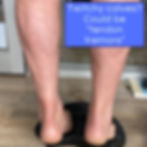Twitchy calves? Could be "Tendon tremor"
- Luke Nelson
- May 6, 2020
- 2 min read
Updated: Jul 15, 2021
Do you notice “shaking” or “twitching” in your calves while performing calf raises? This phenomenon is what researcher Seth O’Neill describes as “tendon tremors”, and is often seen in those with achilles tendinopathy, and most noticeable during the LOWERING (eccentric) phase of a calf raise.

These tremors (or technically called fasciculations or oscillations) indicate a reduced ability of your nervous system to control your muscles as they lengthen, and occur at a rapid rate about 8-12 times per second. These rapid oscillations can actually cause an increased stress on the tendon as it has to go through multiple “stretch-shortening” cycles in quick succession.
In the example in the video below, the patient was suffering from left achilles tendinopathy for 6 months, but also previously had right achilles tendinopathy. We can see the twitching occurs on both sides to some extent with the left side being more obvious. The twitching is also more prominent during the lowering phase of the calf raise.
Not surprisingly when we assessed the soleus strength on our state of the art AxIT system, we found a decrease in strength on both sides with the left side at 74.6kg and right side 82.9kg, which we like to see be at 1.5 x bodyweight (120kg for someone weighing 80kg).
So what’s the solution here?
Well instead of doing an ordinary calf raise, mix it up a bit! Whilst doing a calf raise, instead of just going all the way up and down, vary the height and the speed of the raise as seen in this video. For example, stop halfway up, pause, go back down partially, rise up quickly and keep varying the heights and speed. The theory here is that this type of exercise helps to improve neuromuscular control.
Give it a go, and if you need any assistance with your Achilles or calf issues, please don’t hesitate to contact us at www.healthhp.com.au
References
Grigg, N. L., et al. (2013). "Achilles tendinopathy modulates force-frequency characteristics of eccentric exercise." Med Sci Sports Exerc 45(3): 520-526.
O'Neill, S., et al. (2015). "WHY ARE ECCENTRIC EXERCISES EFFECTIVE FOR ACHILLES TENDINOPATHY?" Int J Sports Phys Ther 10(4): 552-562.
